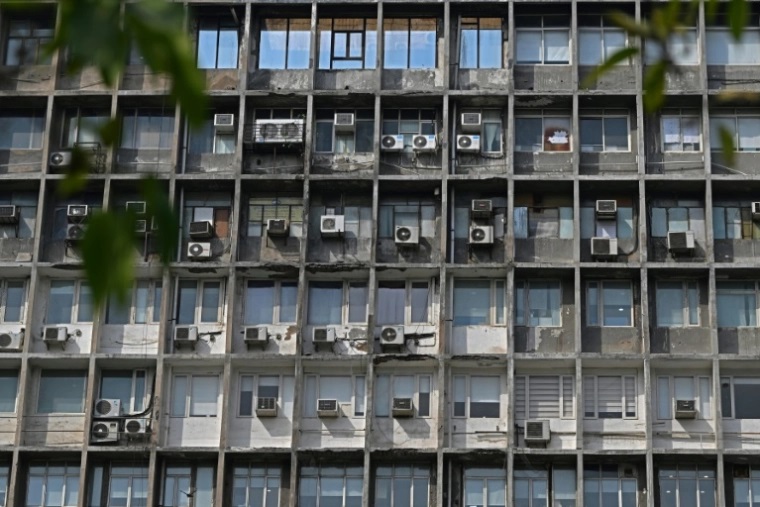Les Indiens achètent 14 millions de climatiseurs par an et ça ne suffit pas
AFP •12/05/2025
"Un climatiseur était devenu indispensable". Comme des millions d'Indiens qui suffoquent chaque année à la saison chaude, Aarti Verma a fait de l'achat de cet équipement sa priorité, même s'il contribue au réchauffement du climat.
Avec la hausse du niveau de vie et des températures, le nombre de climatiseurs vendus dans le pays le plus peuplé de la planète (1,4 milliard d'habitants) devrait passer de 14 millions d'unités en 2024 à 30 millions d'ici 2030.
Mais pour alimenter ces appareils particulièrement énergivores, l'Inde devra, selon les experts, tripler sa production d'électricité.
Le troisième plus grand émetteur de gaz à effet de serre au monde dépend encore du charbon, très polluant, pour son électricité. Il en a consommé un milliard de tonnes en 2024-2025.
En outre, les gaz réfrigérants des climatiseurs, en fuitant, contribuent au réchauffement, tout comme l'air chaud qu'ils rejettent.
Mais pour la commerciale Aarti Verma, 25 ans, qui arpente toute la journée les rues de New Delhi pour voir ses clients, la priorité est ailleurs.
"Quand je rentre chez moi après une longue journée de travail, je veux un minimum de confort", explique la jeune femme, qui gagne 30.000 roupies (310 euros) par mois.
"Avant, je dormais sur la terrasse. Mais il fait désormais si chaud la nuit que le climatiseur est devenu indispensable", explique-t-elle dans son modeste deux-pièces d'un quartier défavorisé de la capitale indienne.
L'Inde est le marché de climatiseurs à la croissance la plus rapide au monde, bien que seulement 7% des foyers en soient équipés.
- Plus un produit de luxe -
"La progression de leurs ventes est essentiellement due à la météo, à la croissance de la classe moyenne, aux bonnes offres de financement et au large accès à l'électricité", selon K.J. Jawa, directeur pour l'Inde du fabricant japonais Daikin.
"Aujourd'hui, ce n'est plus un produit de luxe mais un investissement (...) car une bonne nuit de sommeil est indispensable à notre bien-être mental et physique", explique-t-il à l'AFP.
De plus en plus chauds et longs, les étés indiens ont poussé les consommateurs à s'équiper.
Les habitants sont traditionnellement rompus à ces chaleurs torrides, d'avril à juin, mais le changement climatique a prolongé, multiplié et intensifié leurs épisodes dans le monde entier, ont montré les travaux des scientifiques.
Les nourrissons, les personnes âgées ou malades et tous ceux qui travaillent en extérieur sont particulièrement vulnérables.
Les températures caniculaires sont à l'origine de près de 11.000 décès entre 2012 et 2021, selon les données gouvernementales indiennes.
L'année dernière a été la plus chaude dans le pays depuis 1901, avec la vague de chaleur la plus longue jamais enregistrée et des températures qui ont fréquemment dépassé 45°C.
En mai 2024, la capitale New Delhi a égalé son record battu deux ans plus tôt: 49,2°C.
Selon des études de l'Organisation mondiale de la santé (OMS) et d'ONU-Habitat, les climatiseurs contribuent à augmenter les températures dans les zones urbaines, d'au moins un degré en moyenne, à cause de l'air chaud qu'ils rejettent.
Pour se rafraîchir, Aarti Verma s'est longtemps contentée d'un rafraîchisseur d'air, une énorme - mais rustique et bruyante - turbine posée devant un bac d'eau pour souffler de l'air frais.
- Moins énergivores -
Mais la contrainte de son ravitaillement permanent et la perspective d'y voir s'installer des moustiques l'ont convaincue d'acheter un climatiseur pour l'équivalent de 515 euros, une petite fortune pour elle.
"J'aurais pu acheter de l'or avec cet argent, cela aurait été un bon investissement", ironise-t-elle.
Elle a versé un acompte de 130 euros à l'achat et paiera le reste en mensualités.
En cette très chaude après-midi d'avril, le magasin Imperial Refrigeration, situé dans un vieux quartier de Delhi, ne désemplit pas.
Japsahib Singh Ahuja, 22 ans, dont la famille tient ce commerce depuis 50 ans, se frotte les mains. Ses ventes de climatiseurs ont triplé depuis cinq ans, dopées par les nouveaux clients et ceux qui remplacent leurs vieux appareils.
"Les climatiseurs ne durent pas longtemps car il y a beaucoup de polluants dans l'air de Delhi qui entraînent corrosion et fuites de gaz" réfrigérants, explique le commerçant.
La mégapole de Delhi, qui compte plus de 30 millions d'habitants, est l'une des plus polluées de la planète.
 Des climatiseurs installés aux fenêtres d'un immeuble à New Delhi, en Inde, le 18 avril 2025 ( AFP / Sajjad HUSSAIN )
Des climatiseurs installés aux fenêtres d'un immeuble à New Delhi, en Inde, le 18 avril 2025 ( AFP / Sajjad HUSSAIN )
Selon l'ONU-Environnement, les climatiseurs seront responsables d'un quart des émissions de CO2 de l'Inde et absorberont près de la moitié de sa demande en électricité d'ici 2050.
Mais à ce jour, le pays n'a pas adhéré à son Engagement mondial pour le refroidissement, destiné à réduire l'impact climatique de la climatisation.
Japsahib Singh Ahuja ne s'en inquiète pas, qui constate tous les jours l'appétit de ses clients pour les appareils moins gourmands en électricité.
Les modèles réversibles (chaud/froid), sur lesquels les fabricants règlent par défaut la température à 24°C, arrivent désormais en tête des ventes, remarque le vendeur.
"Les notations de consommation énergétique sont maintenant obligatoires", ajoute-t-il, "nous en profiterons tous".